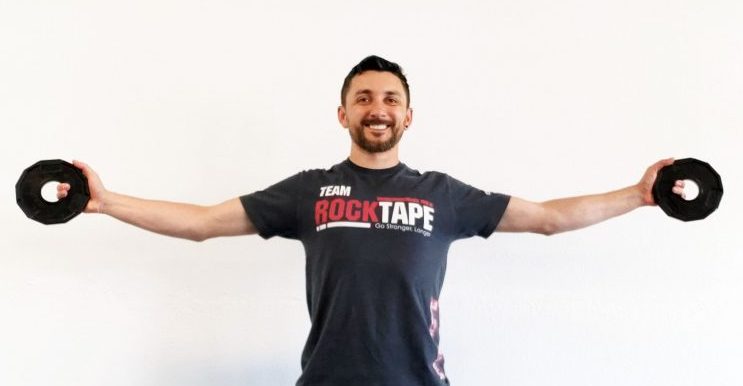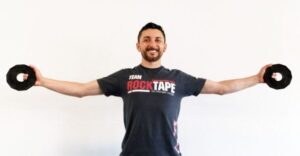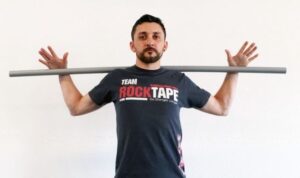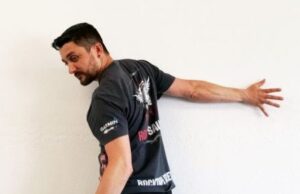Skipping your personal training client’s warm-up can be tempting, that is, until you find the right ones. Making sure your tissues and joints are ready for loading is vitally important to avoiding injury and getting the most out of your workout. I may be a Doctor of Chiropractic, a mobility and rehab specialist, and a personal trainer, but I think my dad said it best: If you’re going to do something, do it right the first time. The following exercises are how certified personal trainers get clients to do upper body workouts right…the first time.
Doctor P’s Plate Shoulder Raises:
What
- Grab some 2.5 LBS or 5 LBS plates, one in each hand.
- Start with your arms out in front, with palms facing down.
- Raise the weights overhead, palms should be facing out.
- Lower them out to each side until you’re at 90 degrees, palms should be front facing.
- Bring them together in front again. Palms should now be facing together.
- Repeat from this position and the palms should finish in front facing upwards on the 2nd rep.
- Turn palms down. Continue!
***Each time your palms are facing up, make sure to rotate them down 180 degrees and start over! - Set a 2 min timer or do 10 reps as a warm-up.
Why
Overhead movement can be stressful for your muscles, joints, capsule, and bursae. Having a slow, controlled, weighted movement to wake up all the stabilizers and floss out some adhesion is just what your body needs before a workout.
Doctor P’s Dowel Shoulder Typewriters:
What
- Grab a dowel/PVC pipe that’s about 4-5 feet long – yo
u can even use a broom handle. - Set it on your shoulders so it’s resting around C7-T1, on the top of your traps behind your neck.
- Wrists are resting on top with hands above level of the bar (no grasping the bar at all).
- Slowly slide the bar as far to the right as you can, extending your right arm, and bringing your left arm in close and squeezing that left shoulder blade back, while keeping BOTH wrists on top of the bar.
- Repeat bilaterally!
- When you get to be a pro, drop it down one vertebral level to make it harder and continue flossing!
***ALWAYS keep your chest and chin tall – never let your head drift forwards. This is a shoulder exercise- your torso and neck shouldn’t be doing anything! - 2 min timer or 10 reps.
Why
Scapular mobility and control mixed with flossing for external rotation? Sign me up. Limitations in those systems are why I see so many sports or lifting injuries in clinic, and why your trainers are there to coach you out of those compensatory positions. If you work on your mobility and control here, you’ll see big changes very quickly and this will be your favorite warm up.
Doctor P’s Pec Wall Hovers:
What
-
- Simple pec wall stretch with a twist.
- Arm abducted to 90 degrees, chest, arm and palm flat against a wall.
- While keeping your arm in place on the wall, slowly rotate your torso away from the wall until you reach tension.
- Now try to lift that same arm an inch or so off the wall! (This will be activating the opposing muscle groups in the back: posterior delt, lower trapezius, and rotator cuff.)
- Ten small and slow circles forwards, 10 backward, going in and out of that tension.
- Repeat with arm 45 degrees upwards, and 45 degrees downwards from the start position.
- 10 forward and backward rotations for each position, bilaterally (repeat both sides!).
Why
‘Cuz I said so! Nah…life and lifting tend to overdevelop tightness in the front of the thorax (pec, pec minor, etc.) and the shoulder will suffer. If it has to move while being constantly tugged forwards, we tend to develop bicipital tendinitis or impingement syndromes, or even rotator cuff strains in our supra and infraspinatus. We don’t want that. So this stretch helps to maintain a good length-tension relationship in our shoulder girdle!
Wrap-Up
Anyone who can do these without pain will notice some functional benefits. Humans tend to develop tightnesses in these areas; I’ve specifically designed these exercises to address those common patterns of dysfunction or tightness. The best thing you can do for yourself is to see if they work for you!
‘[sc name=”stretching” ][/sc]






